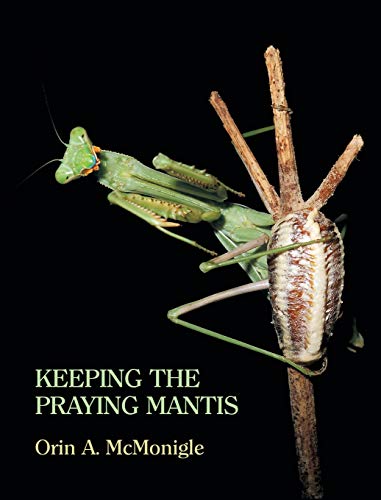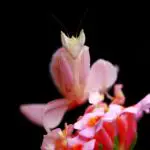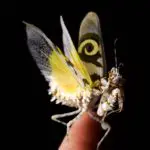The devil flower mantis, or Idolomantis diabolica, is notoriously challenging to keep. But, it is not impossible. In this article, I’ll share everything I know about devil’s flower mantis care.
To keep Idolomantis diabolica as pets, place it in a large, well ventilated enclosure under 30-35 °C. Lay some dried leaves to provide refuge, and a handful of twigs for the mantis to climb. Feed the mantis with only flying insects. Mist the enclosure daily with clean water to keep the humidity between 60-70%.
Known as the holy grail by hobbyists, I. diabolica earned its reputation from its beautiful appearance and difficulties in rearing. It is also not cheap, and not easily available.
Idolomantis diabolica should not be your first pet mantis. Even the most experienced hobbyists have issues keeping the devil’s flower mantis. As such, you must have experience keeping other mantises. If you are looking for the first mantis to keep, you should choose those beginner friendly mantises.
Introduction to Idolomantis diabolica
Idolomantis diabolica is a large mantis that originated from Africa. It is called the devil’s flower mantis, as it mimics flowers to lure the prey. When the prey gets near enough, the devil’s flower strikes.
The average size of adult I. diabolica is around 10-12 cm in length. The female is only slightly larger than the male. Hence, size is not a good measurement to sex the devil’s flower mantis.
Overall, I. diabolica are skittish. They don’t like to be handled. When they feel threatened, they raise their raptorial forelegs, revealing their colorful thorax and abdomen to scare off or confuse their enemies. This is called the deimatic behavior.
Enclosure for Idolomantis diabolica
Idolomantis diabolica requires a big enclosure. For the adult mantis, use an enclosure with around 40 cm height and 30 cm width. If possible, use one with a strong mesh lid, so that the mantis can hang itself on the mesh lid for molting.
Make sure the enclosure has vents for ventilation. This shouldn’t be an issue if you are using an enclosure with a mesh lid.
Idolomantis diabolica are skittish. The risk of cannibalism is low. Hence, you can house them in the same enclosure, making sure there is enough food and space for them. Obviously, only mantises of similar sizes should be housed together.
Lay dried leaves at the bottom of the enclosure. This will provide a venue for the skittish devil’s flower mantis to hide. Some hobbyists simply lay a paper towel on the enclosure floor, and the mantis doesn’t seem to have any issues with that.
The devil’s flower mantis also need a lot of twigs to climb on. Try using smoother twigs to prevent the mantis from getting its leg stuck. While all mantises can regain lost limbs when molting, I. diabolica tend to die from molting if it has a broken leg.
Feeding Idolomantis diabolica
All breeders agree that flying insects should be the main food source for I. diabolica. Depending on the life stages, you can use fruit flies, house flies or blow flies. Crickets, mealworms and roaches are least appealing for this species. You should only use them occasionally.
You can refer to my guide on choices of feeder insects and how to cultivate them for your mantis.
If your mantis refuses to eat, check out the reasons, and how to deal with it in this article.
Temperature
Keep your I. diabolica between 30-35 °C during the day. At night, the temperature can be lower, between 20-25 °C. You can use either a heat lamp, heat mat or incubator to achieve the above temperature.
A heat lamp can be placed directly above the enclosure to provide some extra heats. Avoid using LEDs, since LEDs don’t produce enough heat. Experiment with different wattage and distance to produce the desired temperature.
If you use a heat mat, put it at the corner of the enclosure. This will create a temperature gradient across the enclosure, so that the mantis can move to the zone where it is comfortable with. Make sure you monitor the temperature closely to avoid frying your mantis.
Heat mats with a thermostat should be your first choice. It allows you to control the temperature accurately.
Humidity
It is extremely important to keep the enclosure humidity high. Devil’s flower mantis requires 60-70% humidity. While they can tolerate dryness, high humidity is crucial to ensure they molt successfully.
Mist once or twice a day into the enclosure to keep it humid. Putting a damp towel in the enclosure helps provide extra humidity. If you struggle to maintain the humidity, try reducing the vents. The last resort would be a small water dish or a humidifier.
Make sure you have adequate ventilation. Excessive humidity can also kill your mantis.
Recommended Supplies and Resources
Here are my recommended supplies and resources that you can consider getting for your mantis. I’ll earn a small commission from eligible purchases you make after clicking those links. It helps me maintain this site without additional cost to you.

Keeping the Praying Mantis
This is great book by Orin McMonigle on mantis keeping. Written in an easy to understand and concise manner, this is the ultimate guide that any serious mantis-keepers need to read!
- Enclosure
- Lighting
- Thermometer/Hygrometer
- Heat mat
- Tweezers
- Fly pupa
- Fruit flies
- Small crickets
- Dubai cockroach
- Mealworms
Molting Care
Molting is an important process in the growth of mantises. I. diabolica undergoes 7 to 8 molts in 6 to 9 months to reach adulthood.
Molting is crucial for I. diabolica because they probably have the highest mortality rate among other mantis species in the molting process.
The only thing that you can help is by providing the optimum environment and food to your devil’s flower mantis prior and during the molt. As mentioned earlier, the optimum humidity is around 60-70%, and temperature between 30-35 °C.
Idolomantis diabolica doesn’t climb well on smooth surfaces. Make sure the twigs in the enclosure are set up such that the mantis can reach the mesh lid to molt.
As mentioned earlier, I. diabolica is prone to unsuccessfully molting, especially if it is injured. Avoid handling them unless it is absolutely necessary.
The general molting care for I. diabolica is the same as other mantis species, which you can read here.
How to Sex Devil’s Flower Mantis
Unlike other mantises which have obvious sexual dimorphism, the devil’s flower mantises are more difficult to sex. There are at least 3 ways to sex I. diabolica, but only 2 of them are reliable.
The male devil’s flower mantis has feathery antennae, while the female has short and slender antennae. This is more evident from fifth instar onward. You can also count the abdominal segments, where the females have 6 segments, while the males have 8.
Another way to sex I. diabolica is by looking at the tip of the abdomen. The tip of the female abdomen is pointy, while the one on male is slightly rounded. If you have both male and female, you would notice the difference. But, if you have only 1 mantis, it can be hard to tell. Again, this is more apparent from fifth instar onward.
The most reliable way to sex this species is by counting the abdominal segment. If you have a pair of sharp eyes, you can even sex 2nd instar nymphs using this method.
How to Breed Idolomantis diabolica
Place both male and female adults in the same enclosure. Keep the temperature closer to 35 °C, and humidity around 60-70%. Mating happens naturally at night if they are ready. Since they are communal, you can leave them in the same enclosure until you see egg sacs on the twigs.
Mating can be attempted approximately 2-3 weeks after your mantises turn into adults. If you are keeping the pairs separately, they may need time to acclimate when placed together. Patience is the key.
Male I. diabolica grows faster than the females. You can slow down the growth rate of your male mantis by keeping it under a cooler condition, but not below 20 °C. Conversely, you can accelerate the growth of your female mantis by keeping it at a warmer temperature. Of course, this can be done only after you have sex your mantis.
Viable eggs will hatch in 3-6 weeks. Move them to a separate container before they hatch, to avoid cannibalism.
If this is the first time you attempt to breed mantises, check out my mantis breeding guide.


